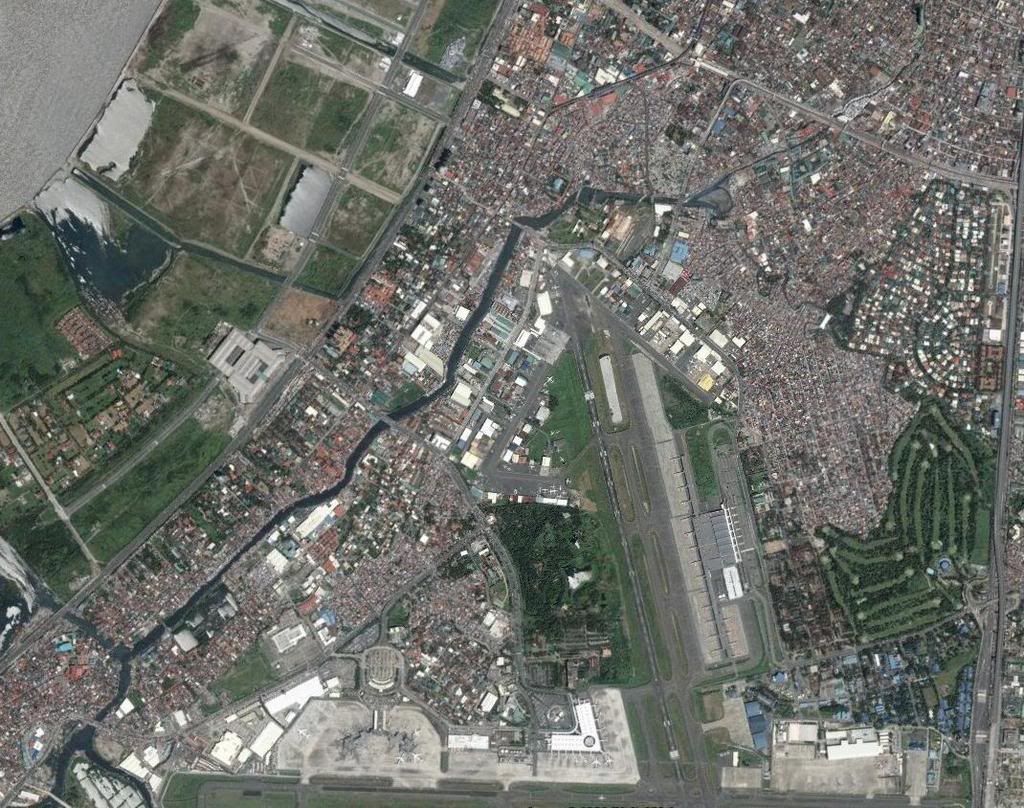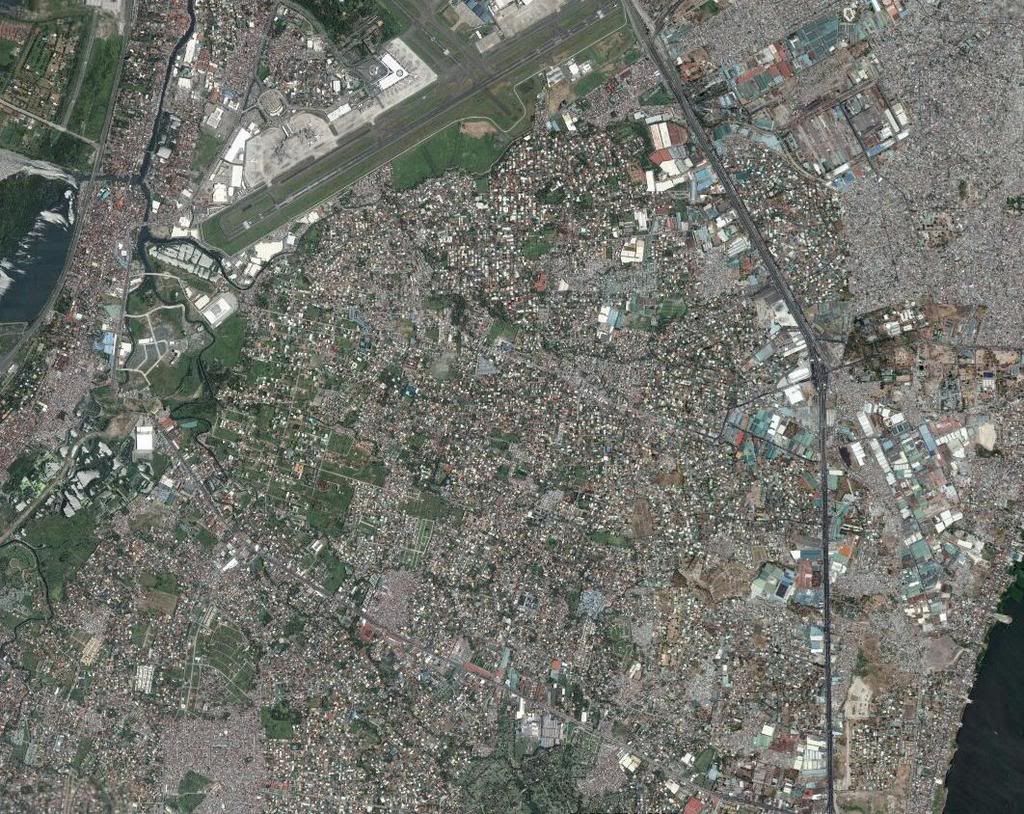

The City of Parañaque (pop. 449,811; 2000 Census), or simply Parañaque (Tagalog: Lungsod ng Parañaque), is one of the cities and municipalities that make up Metro Manila in the Philippines. It is bordered on the north by Pasay City, by Taguig City to the northeast, Muntinlupa City to the southeast, by Las Piñas City to the southwest, and by Manila Bay to the west.
HISTORY
Parañaque was founded in 1572. Since the place lay very proximate to the sea, the Paraqueños did much trade with the Chinese, Indonesians, Indians and Malayans. At that time the main means of livelihood were salt-making, fishing, planting rice, shoemaking, slipper-making and weaving. The community was headed by cabezas de barangay, a westernization of the local chieftains and the principalia as the local aristocrats were called, a very durable social institution since they were the political absorbers. They justified and moderated the demands of the Spanish colonizers. Education was limited to the principalia since it is only they who could afford it. The recorded beginnings of Palanyag began in 1580 when Fr. Diego de Espinar, an Augustinian missionary, was appointed Prior or superior of the convent or religious house of the town. As resident priest, he established the mission house there, with its spiritual jurisdiction reaching up to Kawit in the province of Cavite. The Council of the Definitors (or conference of chiefs of the religious orders) held on May 11, 1580, accepted Palanyag as an independent town. The image of Palanyag's patroness, Nuestra Señora del Buensuceso, was brought to St. Andrew's Church in La Huerta in 1625. Parañaque is home to numerous villages and communities where upper and lower classes reside. Some of the wealthy families (include second houses of politicians, movie stars and socialites) reside in BF Homes Parañaque (also the biggest subdivision in Asia) and Tahanan Village. While other people live in the new and old subdivisions that spur in the land of Parañaque.
Historical accounts state that since Palanyag was located at the crossroads of Manila, the provinces of Cavite and Batangas, the town's strategic location enabled the townspeople to play an important role in Philippine history. During the invasion of the Chinese pirate Limahong in 1574, Parañaque residents, particularly those from Barangay Dongalo, heroically aided in preventing the attack in Manila. This became known as the "Red Sea Incident" due to the blood that flowed as a result of the defense made by the people from barrio Sta. Monica, the barangay's former name. When the British invaded Manila in 1762, the townspeople once again remained loyal to the Spanish colonizers, especially the Augustinians. The invasion however showed that the power of the Spaniards was not invincible and more than a hundred years later, this would prove to be true. Then came the Philippine Revolution (circa late 19th century) and the Spaniards realized that the town was a practical gateway to Cavite, the bastion of the revolutionary Katipuneros. Conversely to the rebels based in Cavite, they saw the town as their gateway to Intramuros, the Spanish seat of government in Manila. Prominent Paraqueños, like Manuel Quiogue and secular priest Father Pedro Dandan became leading revolutionary figures. When the Americans took over, one of the first towns to have a municipal government was Parañaque.
During the Japanese occupation (circa 1940's), Parañaque supplied the leadership of the guerilla movement like the ROTC Hunters as well as food and arms. Parañaque was one of the first towns to be liberated and its guerillas helped in paving the way for American and Philippine forces to enter Manila. As can be gleaned from the above, Parañaque then and now has and continues to play a strategic role in the Philippines' political and economic progress. Another outstanding feature of this historic town by the bay is the cultivation of its cultural traditions like the Komedya, Sunduan, and Bati, among others that continue to attract local and foreign tourists alike, especially during the summer months.
From Palanyag to Parañaque
Palanyag, the old name for the city of Parañaque, generally means "my beloved", among other definitions, for as far as its residents are concerned, this best describes their affection for their hometown. Another version came from the combination of the terms "palayan" and "palalayag", the former meaning ricefields of which the city once abounded in and the latter pertaining to the sailing and fishing occupation of many of its residents. This was also a sign of cooperation and goodwill between the two major working sectors of the town, the farmers and the fishermen. It was however a drunken guest, during a certain affair which decided on the final name, who said "Mabuhay ang Palanyag at ang mga taga-Palanyag! (Long live Palanyag and the people of Palanyag!)" So the name stuck from that day on. Another version, according to tradition, was when a Spanish soldier told the driver of his caruaje or horse-drawn carriage, to "Para aqui, para aqui (Stop here, stop here)!" The driver, uncomprehending, kept on prodding his horse to go on while the soldier angrily repeated his instruction: "Para aqui, para aqui!" Onlookers just laughed as the Spaniards empathically said "para aniya aqui para aniya aqui (he said 'stop here' he said 'stop here)." For days the incident was repeated around and term "para aniya aqui" stuck. There is another story that says of an imposing balete tree at the mouth of the Parañaque. It looked like a boat sailing slowly and majestically, earning the Tagalog term Palanyag, a corruption of the term "palayag" which means "point of navigation". Further adulteration of the word later resulted in the word "palanyaque". A historian believes the town's name may have come from the term "palanas" which means a "broad flat plain," the geographic description of Parañaque.
Other origins of the name Parañaque are "palanac" (with no special meaning), "patanyag" or contest for popularity, and "paranac", a native term for the shell product that used to be the livelihood of the natives of the town at one time. Parañaque, in the olden times, was where many people unboard the "kalesa", or horse-drawn carriage and would usually tell the conductor to "para na aque", which literally means "stop now, boy". The word "para", taken from the Spanish word "parar" which means to stop, "na" is a term in the Filipino language which means "now", and "aque" taken from the Filipino term "lalaki" or "lalake", meaning "boy". The phrase "para na aque" was used so often that it eventually evolved into a term pertaining to a place, thus, Parañaque. An alternative meaning of "para na aque" is "stop here", where the term "'aque'" might have also come from the Spanish word "aqui" which means "here". Whatever the correct origin of the name of Parañaque, the various terms strongly suggest the town's storied and mosaic past.
During the Philippine Revolution, Parañaque became one of the hottest battle zones due to its location halfway between the province of Cavite, where the revolutionaries held sway, and Manila, the seat of the Spanish colonial government.
During the American occupation of the Philippines, Parañaque became one of the first municipalities in the Metro Manila region. Parañaque City was converted as the 11th city in Metro Manila and chartered and urbanized city by Former President Fidel V. Ramos on February 15, 1998.
In May 2001, SM City Sucat (Formerly SM Supercenter Sucat) was formally launched, and it became the 1st SM Mall Franchise in Parañaque City, the Supercenter was changed later to SM City, and it became a larger and wider mall.
In November 2002, the second SM City mall in Parañaque City was launched, SM City Bicutan, becoming one of the most popular malls in Parañaque City after Uniwide Coastal Mall.
In February 2003, the City of Parañaque celebrated their 5th Cityhood Anniversary.
In September 2007, the first strip mall located in Sucat, Parañaque City was "Santana Grove". It has more than 10 restaurants and 1 coffee house chain.
In February 2008, the City of Parañaque celebrated their 10th Cityhood Anniversary.
Etymology
The name "Parañaque" is derived from the phrase "para na aque," which was commonly used in the past when people wished to disembark from kalesas (horse-drawn carriages). The phrase literally means "stop now, boy": "para" from the Spanish parar (to stop), "na" from the Tagalog word for "now" or "already," and "aque" from the Tagalog word for boy, lalaki. An alternative meaning of "para na aque" could be "stop here," with "aque" being derived from the Spanish aquí ("here").
Annual Events
February
Araw ng Palanyag (Parañaque Day), February 15. Originally set on November 30, Araw ng Palanyag or Parañaque Day was moved to January 15 by the City Council to commemorate Parañaque's cityhood anniversary. Usually a week-long affair, the city-wide celebrations include such notable events as the Sambalilo Festival, Regatta de Palanyag, and the Komedya. Komedya. Aside from being a highlight in the celebrations on the Feast of St. Dionisus, Araw ng Palanyag is also commemorated with stage plays called Komedyas or Moro-Moros where local actors and actresses called Komedyantes and Prinsesas take center stage and do choreographed swordfights and render long poetic verses. The stage plays change plots yearly and depicts 16th-17th century romance, religious conflicts, war, and peace. The Komedya was born in the classic community of San Dionisio. They gained national attention and acclaim when the Komedya garnered the top award in the Board of Travel (now Philippine Tourism Authority) - sponsored first Santacruzan Festival in 1958.
March–April
Semana Santa or Holy Week. Most Paraqueños are keen observers of the lenten season which falls between the months of March and April, just like the rest of most of the Christian world. However, the Parañaque folk, being a religious lot, observe such Lenten activities as Linggo ng Palaspas (Palm Sunday), Pasyon, Sinakulo which is a local version of the Via Crucis, and Salubong or Easter Vigil, with a fervent solemnity that may rarely be witnessed in other Catholic communities. Linggo ng Palaspas or Domingo de Ramos starts off the Holy Week with the usual metaphorical rendition of Christ's entry into Jerusalem, with the congregation bringing their palm fronds to church so that they may be blessed; they would afterwards bring home the fronds and display them in their altars believing that these will aid in the plea for the forgiveness of sins and that they will bring blessings from above, keep illness away, and ward off evil. But ultimately, the fronds' main purpose is to serve as reminders of Christ’s passion and salvation.
Pasyon or Pabasa. Monday, Tuesday and Wednesday of the Holy Week is the time when the Pasyon or Pabasa, which is the chanting of the Savior’s life, passion, and death (as well as his Resurrection), is held. It is done in chapels and in residences by groups of community elders, usually 24 hours straight, with a peculiar melody which has been very much attached to the ceremony. Although the actual chanting is done by certain individuals shifting from time to time, such activities revolving around the Pasyon as refreshments, shift-scheduling, financing, and the like are accomplished with the complete cooperation of parishioners.
Sinakulo or Via Crucis (Way of the Cross). On Good Friday, parishes all over Parañaque perform the Sinakulo or Via Crucis (Way of the Cross), a street presentation or a stage enactment of Christ’s arrest, mocking, trial, painful way to Calvary (Golgotha), crucifixion, and death on the cross. Verses are recited and sang while colorful costumes reminiscent of Cecil B. DeMille productions are worn accordingly. There are also actual flagellations and nailings to the cross of penitents as expressions of devotion and penance. Performances are superb and have been critically acclaimed even by the most respected Filipino artists and thespians. Even non-devotees are observed to have been moved to tears by the ceremony. And all these are done under the scorching sun of the Philippines' notorious summers!
Salubong (Easter Vigil) and Pasko ng Pagkabuhay (Feast of the Resurrection). The Easter Festivity unfolds at dawn with the traditional Salubong or Easter Vigil, a procession heralding the resurrection of Christ and his reunion with Mary. While the images of Mother and Son are placed side-by-side, a little girl dressed up like an angel replaces the Blessed Virgin’s black veil of grief and mourning with a white one as the osana, a hymn of praise and adoration endemic to Parañaque, is sung. The Feast culminates with the celebration of a Holy Mass followed by the simultaneous rendition in the different barangays of the Sayaw ng Pagbati, a "Welcome Dance" that is also a Parañaque original. After this, the usual Easter ceremonies are held with much joy and celebration in the communities.
May
Labor Day, May 1. Just like the rest of the world, Parañaque celebrates Labor Day with much applomb and celebration. However, unlike those celebrations observed in other places, there are rarely oratories of proletariat advocacies and emancipation of the masses. On the contrary, Paraqueños celebrate Labor Day as the triumph of economic democracy in the city which is known to be a utopia of labor and management cooperation for the sake of progress and prosperity. Demonstrations from the left are unavoidable, but these are very minimal compared to the solidarity manifested by the majority of Paraqueños who consider class struggle as a myth that is irrelevant to their city. Flores de Mayo. After nine days of prayer, a procession of Sagalas, usually the town’s fairest ladies, is held. Each is assigned a title of Our Lady while the last and most prominent one in the entourage represents Reyna Elena or Queen Helena who found Christ’s cross; the boy escorting her portrays the Queen’s young Constantine. Flores de Mayo is a Spanish term meaning the Flowers of May which figuratively refers to the Sagalas and the offering of flowers to the Blessed Virgin in all the parishes. Ironically, after the offerings, parishioners would then be collecting as much offered flowers as they could gather in the belief that their having been blessed would somehow rub off on them. The Santacruzan is closely associated, sometimes mistaken for and confused with the Flores. Actually, the former is the 9-day period of prayer or novena that comes before the latter. The honor of being Reyna Elena is usually reserved for the family that has volunteered to serve as the major sponsor of the celebration.
Sunduan. The term sunduan is derived from the word sundo which literally means "to fetch" and relates to an old courtship custom of waiting on one’s lady love, accompanying her to the town plaza, and bringing her home. Sunduan is another celebration unique to Parañaque. It conveys the message that Paraqueños are romantics; that their womenfolk are regarded with love and respect; and that Chivalry is alive in Parañaque. But digging deeper into this celebration, the sunduan is another metaphor of Christ's and Mary's ascension to heaven; in this case the young ladies represent the two divinities while the gentlemen take the place of the heavenly spirits. This allegory is strengthened by the fact that although there is no immediate spiritual significance to the ceremony, it is still the parish that usually organizes this event.
Caracol. Barangay Baclaran becomes more alive during the month of May when preparations and the actual celebration of Caracol is observed as a highlight to the township's Feast of Sta. Rita de Cascia, its patron saint. During the affair, Baclaran folk, together with those from the nearby barangays, take to the streets with males wearing drag and females in gentlemen's attire. This merry crowd takes it to task to deliver the august image of Sta. Rita from her shrine in the local parish to Manila Bay and back again in a lengthy procession that signifies renewal of spirit and of devotion to the patron. The merriment would continue unto the twilight hours until such time that the celebrants drop from fatigue and characteristic inebriation for the annual internal change that they go through.
Well i live in this place.
Just lots of gangsters around the city near the municipal hall Valley one







No comments:
Post a Comment